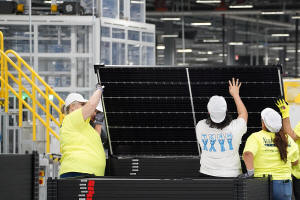As pandemic 'jobs hole' closes, Fed finds labor market easing elusive
 Send a link to a friend
Send a link to a friend
 [January 08, 2024] By
Howard Schneider [January 08, 2024] By
Howard Schneider
WASHINGTON (Reuters) - The U.S. economy ended last year with the labor
scars from the COVID-19 pandemic effectively healed and a quandary for
Federal Reserve policymakers so far waiting in vain for wage and job
growth to cool to a sustainable level.
The addition of 216,000 jobs to U.S. payrolls in December and wage
growth of 4.1% both beat expectations, leaving the central bank still
looking for clear signs of a slowing labor market and prompting traders
in contracts tied to the benchmark federal funds rate to trim
expectations the Fed will start cutting rates at its March meeting.
Monthly job growth of around 100,000 and annual wage growth of around 3%
are the Fed's rough benchmarks for growth in each that would be
considered consistent with the Fed's 2% inflation target.
"Workers still have the upper hand in the current environment, with
strong wage growth and plenty of job opportunities," wrote Nationwide
Senior Economist Ben Ayers. Wage growth remaining above 4% adds to
concern that inflation in labor-intensive services industries may be
hard to quell and represents "another blow to the odds that Fed will cut
rates early this spring."

The Fed held the benchmark interest rate steady at its December meeting
in the current range of from 5.25% to 5.5%. But the language in the
policy statement issued after the Dec. 12-13 session was changed to
allow the possibility that no further rate increases will be needed,
while new projections showed a majority of policymakers expect rate cuts
of three quarters of a percentage point will be appropriate by the end
of the year.
Minutes of that meeting reflected an increased sense among officials
that they may be approaching a point where the risks to jobs and
economic growth posed by the current level of interest rates are more
serious than those posed by inflation that has fallen faster than
expected of late and which by some measures is near the Fed's 2% target
already.
Yet the job market remains a puzzle.
Payroll employment has grown by 14 million over the past three years, a
historic run that not only replaced the positions lost when parts of the
economy were shut down at the start of the pandemic, but are now
slightly beyond the level that would have been reached under the Fed's
benchmark for sustainable job growth.
The unemployment rate has been below 4% since February of 2022.
But while those headline numbers speak to continued strength in
employment, there are also undercurrents that point to slowing.
[to top of second column] |

Employees work on solar panels at the QCells solar energy
manufacturing factory in Dalton, Georgia, U.S., March 2, 2023.
REUTERS/Megan Varner/File Photo

Revisions to prior months lopped 71,000 jobs from the estimated
payroll additions in October and November. On a three-month average
basis monthly payroll growth is now below the average of around
183,000 seen in the decade before the pandemic.
Other aspects of the job market are also easing back to normal,
including time lost to sickness and measures of labor churn like the
worker quits rate, both of which are at or near pre-pandemic levels.
The ratio of job openings to the number of unemployed jobseekers has
also been approaching its pre-pandemic norm.
Minutes of the Fed's December meeting said that "a number" of Fed
officials had begun questioning how much longer tight monetary
policy would be needed, and "pointed to the downside risks to the
economy that would be associated with an overly restrictive stance."
"A few" went further and said the Fed may soon face explicit
tradeoffs between maintaining a healthy job market and continued
progress on inflation.
The Fed under Chair Jerome Powell has so far avoided that difficult
choice, with inflation continuing to fall even alongside job and
wage gains.
That could reflect changes in how the economy works. Fed officials
currently estimate that an unemployment rate of around 4.1% is
consistent with inflation remaining stable at the 2% target, but
improvements in job matching, for example, or in worker productivity
could have pulled that lower at least in the short term.
Or it could just be a delayed reckoning, something worker advocates
said the Fed should stay ahead of.
"Job growth has visibly slowed," said Skanda Amarnath, executive
director of Employ America, pointing to both the revisions in prior
months' payroll numbers based on a survey of businesses and the
weaker employment levels reflected in a separate survey of
households. "The Fed should be rebalancing their focus away from
yesterday's inflation challenges to the potential downside risks the
labor market faces in 2024."
(Reporting by Howard Schneider; Editing by Dan Burns and Andrea
Ricci)
[© 2023 Thomson Reuters. All rights
reserved.]
This material may not be published,
broadcast, rewritten or redistributed.
Thompson Reuters is solely responsible for this content.
 |